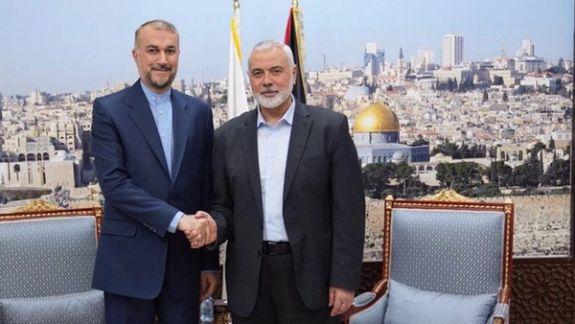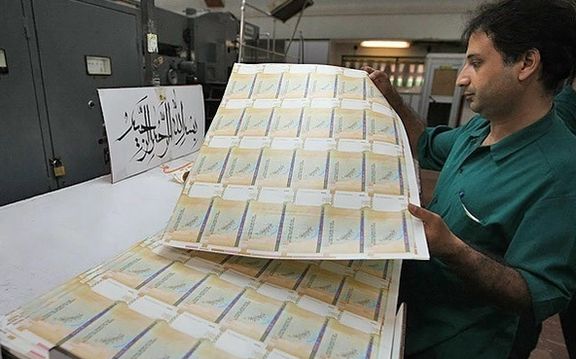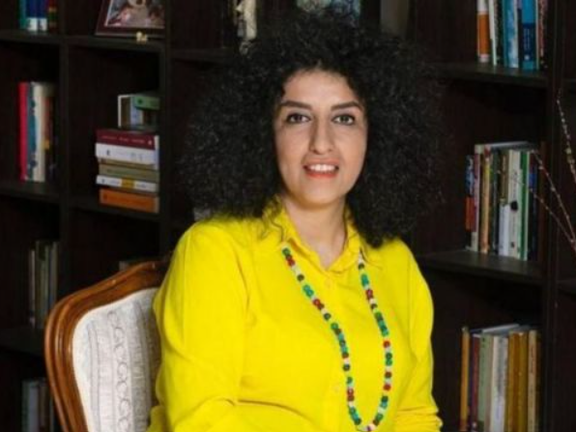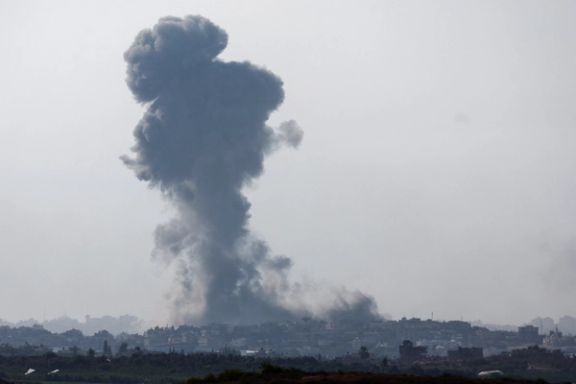Iran’s FM Meets With Hamas Leader In Qatar

The Foreign Minister of Iran has held a meeting with Ismail Haniyeh, the head of the political office of Hamas Islamist militia group, in the Qatari capital Doha.

The Foreign Minister of Iran has held a meeting with Ismail Haniyeh, the head of the political office of Hamas Islamist militia group, in the Qatari capital Doha.
The meeting followed separate talks that Hossein Amir-Abdollahian had with the Emir and the Prime Minister of Qatar on Tuesday. It was the second official meeting between Iran and Hamas since the group, designated as a terrorist group by the US and several other countries, declared war against Israel.
Hamas launched the assault on October 7 with a barrage of at least 3,000 rockets launched at Israel and vehicle-transported incursions into its territory. Palestinian militants breached the Gaza–Israel barrier, targeting both military and civilian populations in neighboring Israeli communities. This included attacks on military bases, nearby towns, and even a music festival near Re'im. Over 350 Israeli soldiers and police officers, as well as more than 1,000 Israeli civilians, lost their lives during the wave of violence, with around 200 civilians and soldiers being taken as hostages to the Gaza Strip, among them, approximately 30 children. Israel has been pounding Gaza in retaliatory fire that has killed thousands of Palestinians.
Iran has expressed its full support for Hamas throughout the conflict and has issued warnings to the United States. Iran's leadership has stated that if the Israeli offensive against Hamas does not cease, it could escalate, potentially impacting American interests in the region.
Amir-Abdollahian, in a speech at the United Nations on Thursday, said that US forces in the Middle East would not be immune to the repercussions if the Israeli offensive against Hamas continues.

Iran’s former chief banker says the government has printed about $5.6 billion worth of national currency in the past year, aggravating the country’s inflation rate.
Abdolnaser Hemmati, the former governor of the Central Bank of Iran (CBI), said Monday that the annual growth of the country’s monetary base was about 41 percent in August, which means that the administration of President Ebrahim Raisi has printed about $460 million per month. Iran’s monetary base growth rate was 11 percent in 2011 and it rose to about 30 percent in the following 10 years. Since Raisi took office in 2021, the figure rose about 10 percent to nearly 42.
The monetary base in a country is the total amount of money created by the central bank, including the total currency circulating in the public, and the currency physically held in the vaults of commercial banks, plus the commercial banks' reserves held in the central bank. Inflation rises when the money supply of a country grows more rapidly than the economic output of a country.
Hemmati criticized the administration for its long promised but unrealistic claim of curbing Iran’s soaring inflation rate, asking, “How is it possible to control inflation with this volume of money printing?”
"Governments in Iran have become accustomed to spending more than they earn, which means they manage the country's finances by creating liquidity. In fact, the discrepancies in (the budgets of) the government, banks, and pension funds are all the result of overspending compared to income," he noted.

Hemmati described inflation as "the worst and most destructive form of taxation that halts savings and disrupts investment,” saying, “Although one of the reasons, and not the only reason, for inflation is negative shocks in the foreign currency market, trying to stabilize rial’s exchange rate without turning off the inflation engine results in more corruption, more capital flight, and further shocks in the currency market.”
Kamran Nadri, an economic expert and a university professor, said in an interview with KhabarOnline that the growth in the monetary base will lead to an even higher inflation rate. “Concerns regarding the inflationary effects of increasing the monetary base... are valid, and policymakers should take this matter seriously.”
Nadri added that the Central Bank tries to control the foreign currency market with government-mandated exchange rates, but this method has grave consequences. “For example, due to the volatile economic conditions and the possibility of the return of US maximum pressure sanctions, there is a risk that a shock in the currency market is triggered by even the slightest fluctuation, resulting in an increasing inflation.”
The warnings of accelerating inflation came as the Statistics Center of Iran (SCI) put the household inflation rate at 45.5 percent. According to SCI’s latest report released Monday, inflation was over 50 percent in about 10 provinces of the country, about one-third of the total.
The officials in the Raisi administration defend their economic policies and try to deflect the blame for the high inflation and devaluation of rial to the previous administration. Government spokesperson Ali Bahadori Jahromi said Tuesday that “no one can forget the 60% inflation and other negative economic indices of the administration of Hassan Rouhani.”
In 1978 before the revolution, one US dollar bought 70 rials, compared with around 40,000 in early 2018, and 500,000 now. The United States withdrew from the JCPOA nuclear deal in May 2018 and imposed both oil export and international banking restrictions on Iran, the so-called maximum pressure campaign. That quickly translated into higher inflation and a hasty retreat of the rial. The process has only picked up speed in the past year, as the rial fell from 260,000 to 500,000 per dollar.
Lawmaker Masoud Pezeshkian said Tuesday that problems that endanger the livelihood of people have worsened under the administration of Raisi, who have failed to keep up with his campaign promises. "Mr. Raisi promised to halve the inflation at the beginning of his term, but not only did inflation not decrease by half, but it rose significantly. Purchasing power has significantly declined, and ordinary employees can no longer afford their daily needs," he said.
Supreme Leader Ali Khamenei's Chief of Staff Mohammad Mohammadi Golpayegani confirmed the alarming number of people living in poverty in the country, claiming that people’s livelihood is one of the most pressing issues for Khamenei.
The SCI and the CBI claim that the rate of annual inflation has dropped to 45.5 percent, nearly the same level as a year ago, and the economic growth rate rose to above six percent between April and July. But official figures tend to underreport bad news and cannot be independently verified. One thing which is clear is that food prices have risen much faster than the official inflation rate, in some instances hitting 100-percent in 2022.
Many reports by local media say prices for some food items have also doubled in 2023, since last year. For instance, based on the figures released by the SCI, the price of mutton and beef have risen by 151 and 132 percent respectively this year.
Despite the government’s claims of economic success, a central bank report in September showed that the money supply increased by 45% this year, heralding higher inflation. In his speeches, Raisi boasts about controlling inflation and reducing money printing, and promises that the 50-percent inflation rate will drop to 30 percent by March 2024.
However, the report by the Central Bank of Iran (CBI) indicated that in April 2023 the money supply showed a 45-percent growth over the same time last year. Money in circulation reached a staggering 88,700,000 trillion rials or around $177.4 billion calculated based on the exchange rate of 500,000 rials per dollar. This is the highest level of money in circulation in Iran’s history, fueled by the government’s borrowing from the CBI that inevitably leads to printing money without any foreign currency or gold backing.
The Islamic Republic has always been printing excess money in its 44-year history, but at different tempos. When oil export revenues were high enough to support government expenditures, less money was printed. However, when oil prices declined or Iran was subjected to oil export sanctions, printing increased and rial’s value suffered.

Narges Mohammadi, an Iranian human rights activist and the Nobel Peace Prize laureate for 2023, has been refused hospital treatment for refusing to wear a hijab.
Alieh Motallebzadeh, a civil activist and women's rights advocate, said Mohammadi was refused treatment for a second time on Monday on grounds that she is not following mandatory state laws over wearing the hijab.
Motallebzadeh said: "Unfortunately, Narges Mohammadi's health is not good; her heart veins are blocked, and she needs angioplasty. However, authorities have refused to transfer her to a medical facility because Narges steadfastly refuses to wear the headscarf."
Mohammadi, a vocal advocate for women's rights and a key figure in the Women, Life, Freedom protests, has consistently expressed her opposition to compulsory hijab in Iran.
In recent months, Mohammadi, 51, has written multiple letters from Evin Prison, where she has been confined since November 2021, serving a twelve-year sentence on charges that include "propaganda against the Islamic Republic." She has consistently refuted the allegations which were levied against her following her public stance against the death penalty.
Mohammadi, who serves as the co-founder and chairperson of the Defenders of Human Rights Center, has experienced detention and imprisonment on several occasions throughout the last twenty years.

Iran’s Attorney General has officially designated any action promoting, strengthening, or supporting Israel online illegal.
The decision also encompasses providing services to platforms associated with Israel and facilitating the travel of Iranian citizens to the country through online means.
The Law on “Confronting Hostile Actions by the Zionist Regime Against Peace and Security”, was submitted to the parliament and approved during an open session in 2020. The legislation was recently updated by the Committee for Determining Instances of Criminal Content.
The update also “extends to any collaboration, interaction or exchange of information with both official and unofficial entities and individuals affiliated with the Israeli regime.”
The legislation reflects Iran's long standing stance as an opponent of Israel, whose destruction it has called upon for decades, reversing the good relations the countries shared before the revolution of 1979.
Iran has historically barred its athletes from competing against Israeli counterparts, leading to athletes intentionally losing games, forfeiting matches, or claiming injury under pressure from sports federation officials to avoid facing Israelis.
Supreme Leader Ali Khamenei has consistently lauded Iranian athletes who refuse to compete against Israelis and as recently as September 2021, encouraged them to persist in their stance, even if facing potential repercussions from international sports governing bodies.

Abolfazl Qadiani (Ghadiani), an outspoken opponent of Iran's Supreme Leader Ali Khamenei has condemned the murder of Armita Geravand.
He stated that the murder of the teenage girl adds another dark chapter to the already troubling record of Khamenei.
Qadiani asserted, "The murder was committed by the hijab enforcers of Khamenei, the power-hungry ruler of Iran. Armita has now joined Mahsa Amini."
Armita, 16, fell into a coma following an encounter with hijab enforcers in the Tehran subway. Despite the government's efforts to obscure the details, it appears that she was pushed by a female agent, resulting in a severe head injury.
Security measures were imposed to prevent the dissemination of information, photographs, or CCTV footage from the scene at Tehran's Fajr Hospital. Tragically, Armita was declared brain dead and subsequently died in the hospital on Saturday.
Qadiani, a 78-year-old former Islamic-leftist revolutionary and former comrade-in-arms of Khamenei, has become an unyielding opponent of the regime. He highlighted the regime's desperate attempts to fabricate a false narrative, attempting to portray Armita's coma in the subway car as a normal and natural occurrence.
He stressed that such murders and crimes cannot save Khamenei and his regime from their impending downfall and held all those involved in the murder, from the hijab enforcers to their leaders and commanders, accountable. However, he blamed the main culprit as Ali Khamenei, saying he must be “held accountable for all the killings, injustices, and suppressions, given that his illegitimate, unlawful, and invasive regime continues to persist.”

While Iran’s regime has been increasingly insisting that it has no proxy forces in the region, its militant allies have been targeting Israel and US forces.
Houthi forces in Yemen, armed with Iranian weapons, launched drones toward the Israeli port of Eilat on Tuesday that were intercepted over the Red Sea. At the same times, another drone attack targeted the Ain al-Asad air base in Iraq, where US forces are stationed. An Iraqi Islamist group aligned with Iran took responsibility for the strike.
However, Iran’s foreign minister Hossein Amir-Abdollahian told CNN last week that the Islamic Republic was not involved in recent attacks against US bases, insisting that no group takes orders from Tehran, and that Iran has no proxies in the region.
For years, the Iranian regime has been making triumphant statements about its leadership of the “resistance axis”, that includes militant groups, such as the Lebanese Hezbollah, Iraqi Shiite militias, the Houthis in Yemen and the Syrian regime, to name the most prominent forces supported financially and militarily by Tehran.
The Iranian regime has become the focus of attention in the West after the terror attack on Israel by Hamas, another militant group it supports. Although voicing unequivocal support for Hamas, Tehran has been denying any role in the bloody invasion that killed around 1,400 Israelis.

The United States has warned Iran not to escalate the Gaza war and has dispatched substantial naval forces to the region as a deterrent to Tehran and its most powerful proxy, the Hezbollah, which can open a second front against Israel in the north.
Notably, Kayhan, the most hardliner newspaper in Tehran on Tuesday declared that the Islamic Republic will not enter a war for any other nation.
Kayhan stated, “The discourse of the Islamic Revolution is based on awakening and empowering nations. Moreover, it supports and strengthens any oppressed people who desire freedom. However, it never engages in any war on behalf of any other nation and this exact strategy has effectively thwarted various scenarios presented by the United States against Iran in the West Asian region.”
Iran’s strategy since the 1980s, when it helped establish the Hezbollah, has been to use militant and violent groups to build influence around the world and target the interests of Israel and Western countries.
Kayhan is financed by the office of Iran’s ruler Ali Khamenei and is seen as reflecting the views of his office, especially when promulgating hardline foreign policy dictums.
While Hezbollah has had skirmishes with Israeli forces in the past three weeks, it has so far avoided a full-fledged war. Some observers argue that as time goes on and the Israeli ground offensive in Gaza progresses, the opportunity and perhaps the will for the Shiite group to risk total war with Israel decreases.
Israel said on Tuesday that its forces were already attacking Hamas gunmen inside the militants' vast tunnel network in Gaza after Prime Minister Benjamin Netanyahu dismissed calls for a halt to fighting to ease a worsening humanitarian crisis.
The gradual Israeli progress and Hezbollah inaction influence calculations in Tehran, which prefers to use proxies to a limited degree to show support for Hamas but avoid a full escalation that can endanger to regime.
Houthis also escalated clashes with Saudi Arabia in Yemen, after nearly two years of relative calm. They had already fired cruise missiles and drones, potentially toward Israel on October 19 that were intercepted by a US Navy warship.